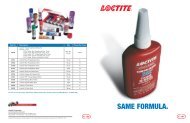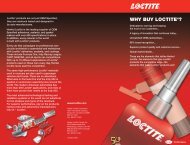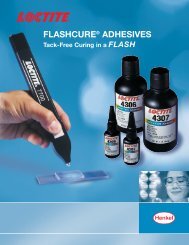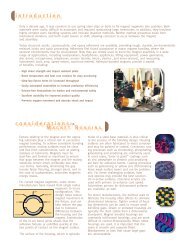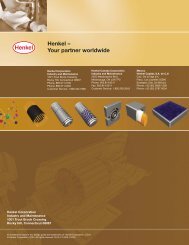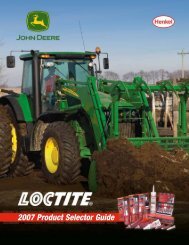Did You Know?Durometer HardnessDurometer hardness is a property presented on technical data sheetsthat shows how hard the resin is in the cured state. A durometer gaugeis the actual measuring device consisting of a small drill or bluntindentor point under pressure. Different measurement scales are usedfor different materials depending on how soft or hard the material. Thefollowing chart compares three (3) different graduated measurementscales and relates hardness values to some common objects as well as<strong>Loctite</strong> ® brand products.Shore A Shore D Rockwell M Reference Object<strong>Loctite</strong> ® BrandProduct30 Art Gum Eraser 5140 40 Pink Pearl Eraser 5900 ®50 15 Rubber Stamp –60 Pencil Eraser 5699 70 30 Rubber Heel –80 Rubber Sole –90 45 Typewriter Roller 366 100 55 Pipe Stem 3106 74 0 Textbook Cover 334 78 32 Douglas Fir Plywood –82 63 E-60HP 86 95 Hardwood Desktop –90 125 Glass or Formica –The higher the number within each scale, the harder the material.Shore readings are typically used for plastics. Shore A is for softermaterials; Shore D is for harder materials. Rockwell readings aretypically used for metals.Mathematical ConversionsThe following are some common conversions that might be helpfulwhen utilizing <strong>Loctite</strong> ® brand products:• 1 milliliter (ml) = 1 cubic centimeter (cc)• 1,000 ml = 1 liter• 29.5 ml = 1 fl. oz.• 3.78 liters = 1 gallon• 473 ml = 1 pint• 454 grams = 1 lb.• 947 ml = 1 quart• 1 kilogram = 2.2 lbs.• Weight to <strong>Volume</strong>: grams ÷ specific gravity = cc (ml)• <strong>Volume</strong> to Weight: cc (ml) x specific gravity = grams• Density = specific gravity x 0.99823• Centipoises = centistokes x density (at a given temp.)• Temperature: degrees F - 32 x 0.556 = degrees Cdegrees C x 2 -10% + 32 = degrees F• Square Inches to Square Feet: ÷ by 144• Square Feet to Square Inches: x by 144• In./lbs. ÷ 12 = ft./lbs.• Ft./lbs. x 12 = in./lbs.• 16 in. oz. = 1 in. lb.• 192 in. oz. = 1 ft. lb.Area CoverageFlat Parts:Length(in.) x Width(in.) x Bondline Thickness(in.) x 16.4 = cc/mlrequirement per partNon-threaded Cylindrical Parts:Diameter x Engagement Length x Bondline Thickness(on radius/per side) x 3.14 x 16.4 = cc/ml requirement per partPotting/ Encapsulating Applications:Area (3.14 x R2 ) x Potting Depth x 16.4 = cc/mlrequirement per partFor no induced gap, make the bondline thickness figure 0.001".16.4 is a constant for converting cubic inches to cubic centimeters.88The <strong>Loctite</strong> ® Design Guide for Bonding Plastics, <strong>Volume</strong> 4
ViscosityViscosity is a product property you’ll find associated with all <strong>Loctite</strong> ® brandadhesive/sealants. Viscosity is defined as a measure of the resistance of afluid to flow (usually through a specific orifice). A measure of this fluid“thickness” is expressed in centipoise values. The higher the number, thethicker the product. Thicker products are less flowable, and in most cases,will fill a larger gap if necessary. The following chart relates viscosity tosome products we are all familiar with:<strong>Loctite</strong> ® Brand Product ExamplesProductApproximateViscosity inCentipose (cP)CyanoacrylatesAnaerobicsWater at 70°C 1-5 420 –Blood orKeroseneAnti-Freeze orEthylene GlycolMotor Oil SAE 10or Corn OilMotor Oil SAE 30or Maple SyrupMotor Oil SAE 40or Castor OilMotor Oil SAE 60or GlycerinCorn Syrup orHoneyBlackstrapMolasses10 – 290 15 406 Letter Grade A50 -100 414 / 496 609 150-200 – 675 250-500 4203 / 4471 640 1,000-2,000 403 / 422 222MS /242 ® / 262 2,000-3,000 410 / 4211 635 5,000-10,000 411 / 382 277 / 620 Chocolate Syrup 10,000-25,000 – 324 / 326 Ketchup orMustardTomato Paste orPeanut ButterShortening orLardCaulkingCompound50,000-70,000 409 330 150,000-250,000 – 592 1,000,000-2,000,0005,000,000-10,000,000– 660 – 593 Window Putty 100,000,000 – –Some products are considered thixotropic. This describes materials that aregel-like at rest but fluid when agitated. Ketchup is a good example that exhibitsthis property. <strong>Loctite</strong> ® brand products include <strong>Loctite</strong> ® 262 Threadlocker and<strong>Loctite</strong> ® 509 Flange Sealant.Shelf LifeWhat is the Henkel shelf life policy for <strong>Loctite</strong> ® brand products?The shelf life period for <strong>Loctite</strong> ® brand products is one year from date ofshipment from Henkel facilities or as indicated by package labeling. Foroptimal storage, maintain product at a temperature between 8°C (46°F)to 21°C (70°F). Storage below 8°C (46°F) or greater than 28°C (82°F)can adversely affect product properties. Cyanoacrylate products mustbe stored under refrigerated conditions at 2°C (36°F) to 8°C (46°F).Storage below 2°C (36°F) or greater than 8°C (46°F) can adverselyaffect product properties. Products requiring storage at conditions otherthan those specified here are labeled accordingly. Material removedfrom containers may be contaminated during use. Do not return productto original containers. Henkel cannot assume responsibility for productwhich has been contaminated or stored under conditions other than asrecommended. This policy supersedes all previous policies regardingshelf life and storage of <strong>Loctite</strong> ® brand products.Do the 10 character batch codes on containers signify thedate of shipment?NO... This code signifies date of manufacture. Certified shelf life isbased on this code only if date of shipment cannot be determined. Thisis generally 2 years from date of manufacturing for most products.In most cases this process of checking batch codes, predates theadoption of a “Use by Date” which is on the unit label and case cartonsof most <strong>Loctite</strong> ® Brand Industrial Products.How do you read this 10 character batch code?example:Henkel InternalCodeLast digit in year ofmanufacture. 6=2006PP 6 A NN XXXXPack VariableMonth within year of manufacture, (e.g. A = January, B =February, C = March, etc., excluding the letter I, J = September).NOTE: The Batch Code may be truncated on small package sizes, but theyear and date will not be compromised when this is done.Lot Number CodeOnce a product reaches its “1 year from date of shipment”date, does this mean it can no longer be used?No... Henkel offers a policy for extension of shelf life.Contact Customer Service (800-243-4874) for details.The <strong>Loctite</strong> ® Design Guide for Bonding Plastics, <strong>Volume</strong> 4 89



